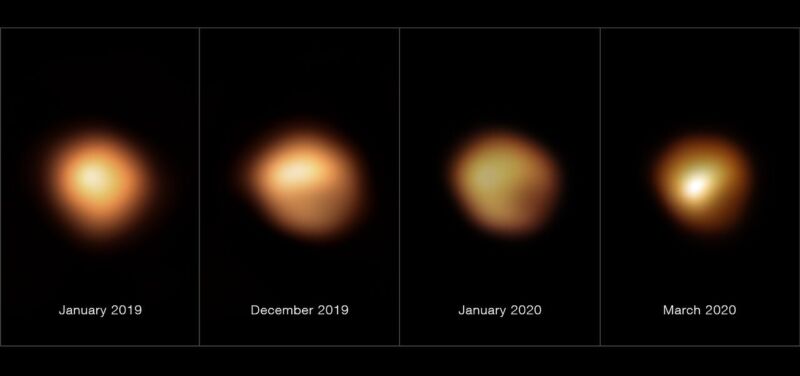Over the last couple of years, Ars has dedicated a fair number of electrons to our local red supergiant, Betelgeuse. The massive star went through an odd uneven dimming, leaving the astronomy community scrambling for explanations and observation time. While a degree of consensus slowly emerged, the lack of some key details left a lot unexplained.
It turns out that some of the answers were accidentally captured by an Earth-facing Japanese weather satellite that had Betelgeuse in-frame across the entire process of its dimming.
In the archives
In the new paper describing the results, Daisuke Taniguchi, Kazuya Yamazaki, and Shinsuke Uno say the astronomy community has settled on two options for explaining why a giant star like Betelgeuse might get dimmer. One is that internal processes could lower the star's effective temperature and thus its light output. The other option is that dust ends up between the star and Earth, absorbing some of the star's light. But both of those explanations are short on details; we don't really know what's happening inside the star or how enough dust could end up between Betelgeuse and Earth.
Figuring out what's going on requires us to image the star at wavelengths that can identify the presence (or absence) of dust. But most of the wavelengths that help us image dust are absorbed by the Earth's atmosphere, meaning space-based observatories are the best option. But we didn't happen to have them pointed at Betelgeuse as the dimming started.
Or so we thought. Taniguchi, Yamazaki, and Uno say that one was pointed at Betelgeuse this entire period. It just happened to be Himawari-8, an Earth-facing weather satellite.
Himawari-8 is a geostationary satellite that, starting in 2015, has been regularly imaging Earth in visible and infrared wavelengths. Inevitably, some of those images contain the stars near the Earth's rim from the satellite's perspective. One of those stars was Betelgeuse, which shows up about once every day and a half. So, thanks to Himawari-8, we have about 4.5 years of observations of the star at visible and infrared wavelengths.
¿Por qué no los dos?
By comparing the light at different wavelengths, the three astronomers tracked a number of the star's parameters throughout the great dimming. These include the apparent radius of the star, its effective temperature, and the amount of light obscured by dust. These measurements indicated that the star cools off during the dimming, with its effective temperature dropping by about 140 Kelvin. But there was an increase in dust at the same time. So the dimming appears to have two causes.
These findings are roughly in line with observations made after the event had started, which led researchers to conclude that both dust and a cool spot on the star were responsible for the dimming.
By going back before the event, the Himawari-8 observations may tell us something about how the dust got there. It's likely that, before the dimming, Betelgeuse ejected matter that only formed dust after it had cooled down. The researchers tracked the behavior of water in the environment near the star, which showed that, somewhat prior to the onset of the dimming, the water shifted from emitting light at this wavelength to absorbing it. This change happened rapidly—they estimate that it took a week or less.
The researchers suggest one explanation for this rapid change is a shockwave that reached a cloud of water that formed from the material ejected by Betelgeuse. And the onset correlates with when the dust began to lower the light reaching Earth from the star. Taniguchi, Yamazaki, and Uno aren't sure what the connection between the two is, but they suspect that the timing is unlikely to be coincidental.
Nature Astronomy, 2022. DOI: 10.1038/s41550-022-01680-5 (About DOIs).



3175x175(CURRENT).thumb.jpg.b05acc060982b36f5891ba728e6d953c.jpg)

Recommended Comments
There are no comments to display.
Join the conversation
You can post now and register later. If you have an account, sign in now to post with your account.
Note: Your post will require moderator approval before it will be visible.